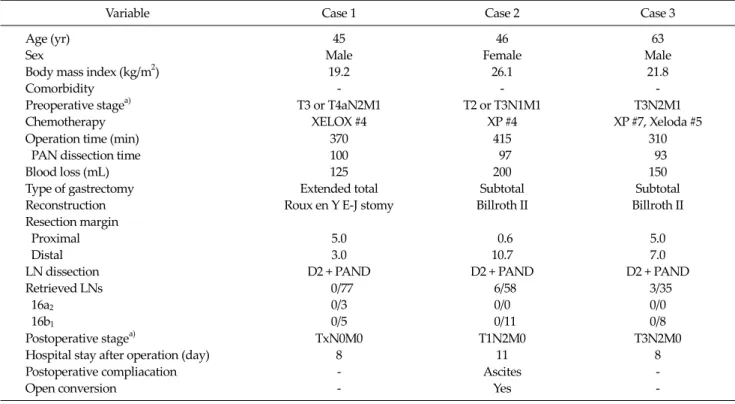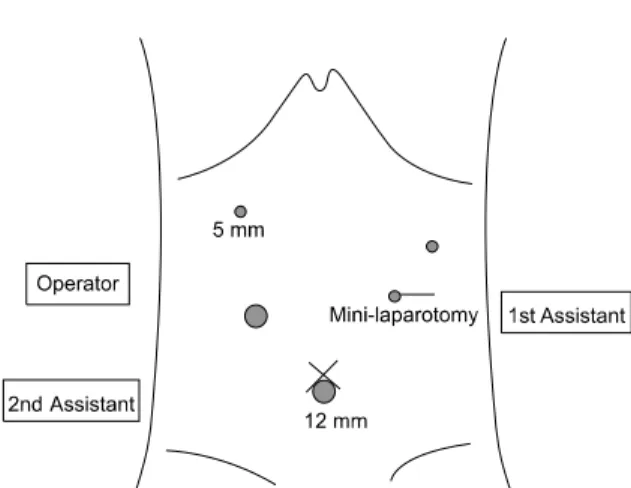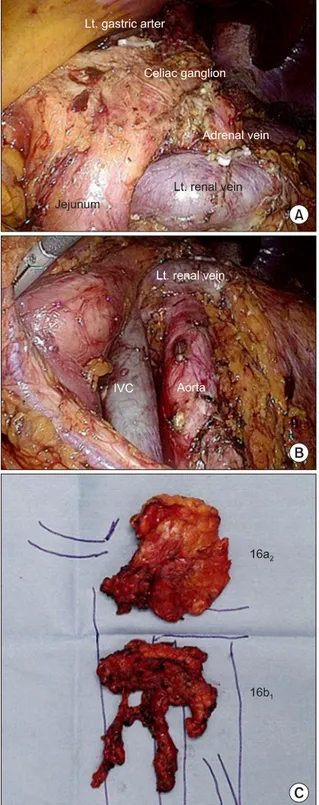J Korean Surg Soc 2013;84:304-308 http://dx.doi.org/10.4174/jkss.2013.84.5.304
CASE REPORT
JKSS JKSS JKSS
Journal of the Korean Surgical Society pISSN 2233-7903ㆍeISSN 2093-0488
Received October 17, 2012, Revised January 26, 2013, Accepted February 12, 2013 Correspondence to: Hyung-Ho Kim
Department of Surgery, Seoul National University Bundang Hospital, Seoul National University College of Medicine, 82 Gumi-ro 173beon-gil, Bundang-gu, Seongnam 463-707, Korea
Tel: +82-31-787-7095, Fax: +82-31-787-4055, E-mail: hhkim@snubh.org
cc Journal of the Korean Surgical Society is an Open Access Journal. All articles are distributed under the terms of the Creative Commons Attribution Non-Commercial License (http://creativecommons.org/licenses/by-nc/3.0/) which permits unrestricted non-commercial use, distribution, and reproduction in any medium, provided the original work is properly cited.
Laparoscopy-assisted gastrectomy with para-aortic lymphadenectomy after palliative chemotherapy for advanced gastric cancer with isolated para-aortic lymph node metastasis
Sang-Yong Son, Chang Min Lee, Ju-Hee Lee, Sang-Hoon Ahn, Jin Won Kim
1, Kuhn-Uk Lee
1, Do Joong Park, Hyung-Ho Kim
Departments of Surgery and 1Internal Medicine, Seoul National University Bundang Hospital, Seongnam, Korea
Prophylactic para-aortic lymphadenectomy is not recommended in curable advanced gastric cancer. However, there are few reports on therapeutic para-aortic lymphadenectomy after palliative chemotherapy in far advanced gastric cancer. We report three cases of laparoscopy-assisted gastrectomy with para-aortic lymphadenectomy after palliative chemotherapy for the first time in Korea. Three gastric cancer patients with isolated para-aortic lymph node (PAN) metastasis showed partial re- sponse to capecitabine-based chemotherapy, and laparoscopy-assisted gastrectomy with para-aortic lymphadenectomy was performed with curative intent. The mean total operation time was 365 minutes (range, 310 to 415 minutes), and the mean es- timated blood loss was 158 mL (range, 125 to 200 mL). The mean number of retrieved PAN was 9 (range, 8 to 11), and all pathologic results showed no metastasis of para-aortic region. All patients recovered and were discharged without any sig- nificant complications.
Key Words: Laparoscopy, Gastric cancer, Para-aortic lymphadenectomy
INTRODUCTION
The survival of gastric cancer has steadily improved in the past decade along with advanced diagnostics and screening programs and improvement of chemotherapy.
However, the prognosis of unresectable gastric cancer is still poor, with peritoneal seeding, distant metastasis, and distant lymph node metastasis.
Para-aortic lymph node (PAN) metastasis is considered a distant lymph node metastasis. The prognosis of gastric cancer with PAN metastasis is quite poor even after pro- phylactic para-aortic lymphadenectomy [1]. For this rea- son, systemic chemotherapy is commonly preferred as a primary mode of treatment in these patients. Various kinds of chemotherapeutic regiments including 5-fluo- rouracil, cisplatin, irinotecan, taxans, and capecitabine
Variable Case 1 Case 2 Case 3 Age (yr)
Sex
Body mass index (kg/m2) Comorbidity
Preoperative stagea) Chemotherapy
45 Male
19.2 - T3 or T4aN2M1
XELOX #4
46 Female
26.1 - T2 or T3N1M1
XP #4
63 Male
21.8 - T3N2M1 XP #7, Xeloda #5 Operation time (min)
PAN dissection time Blood loss (mL) Type of gastrectomy Reconstruction Resection margin Proximal Distal LN dissection Retrieved LNs 16a2
16b1
370 100 125 Extended total Roux en Y E-J stomy
5.0 3.0 D2 + PAND
0/77 0/3 0/5
415 97 200 Subtotal Billroth II
0.6 10.7 D2 + PAND
6/58 0/0 0/11
310 93 150 Subtotal Billroth II
5.0 7.0 D2 + PAND
3/35 0/0 0/8 Postoperative stagea)
Hospital stay after operation (day) Postoperative compliacation Open conversion
TxN0M0 8 - -
T1N2M0 11 Ascites
Yes
T3N2M0 8 - - PAN, para-aortic lymph node; PAND, para-aortic lymph node dissection; LN, lymph node.
a)Stage: 7th edition tumor-node-metastasis classification system by the American Joint Committee on Cancer.
Table 1. Summary of clinicopathlogical characteristics and operative outcomes were widely used in the past decades. The clinical re-
sponse ratio of palliative chemotherapy in gastric cancer with PAN metastasis was reported up to 68.8% [2].
Recently several cases of therapeutic gastrectomy with para-aortic lymphadenectomy after chemotherapy were reported [2-4], but the efficacy of gastrectomy with para-aortic lymphadenectomy after chemotherapy re- mains still unclear.
Laparoscopy-assisted gastrectomy is an option in the treatment of gastric cancer, and the indication for this pro- cedure has extended to locally advanced gastric cancer.
However, there was no report of laparoscopic para-aortic lymphadenectomy in gastric cancer except laparoscopic biopsy of PAN for the staging [5]. Herein, we report three cases of laparoscopy-assisted gastrectomy with para-aort- ic lymphadenectomy after palliative chemotherapy for far advanced gastric cancer for the first time in Korea.
CASE REPORTS
The details of three cases are summarized in Table 1.
Case 1
A 45 year-old man was diagnosed with a poorly differ- entiated adenocarcinoma in the gastric angle by gastro- scopy. A positron emission tomography-computed to- mography (PET-CT) suggested left para-aortic and aorto- caval lymph node metastasis. After completing 4 cycles of XELOX, the patient showed partial response to the chemo- therapy with decreased extent of primary cancer and ret- roperitoneal lymph nodes. After the confirmation of no evidence of seeding in the diagnostic laparoscopy, he un- derwent a successful laparoscopic extended total gas- trectomy with para-aortic lymphadenectomy with the usual 5-port system without additional port insertion. The total operative time was 370 minutes and para-aortic lym- phadenectomy took 100 minutes. The estimated blood loss (EBL) was 125 mL. The pathologic results revealed no re- sidual primary tumor and no lymph node metastasis in
Fig. 1. Ports placement for laparoscopy-assisted total gastrectomy with para-aortic lymphadenectomy.
harvested 77 lymph nodes (LNs; 16a2 [0/3], 16b1 [0/5]). He recovered and was discharged at postoperative 8 days without any complications.
Case 2
A 46 year-old woman was diagnosed with a poorly dif- ferentiated adenocarcinoma in the gastric body, and CT suggested bulky perigastric lymph nodes (station 3 and 7, 2.0 cm and 1.0 cm) and left PAN metastasis (2.2 cm). After completing 4 cycles of XP, she showed partial response to the chemotherapy with decreased sizes of perigastric (0.9 cm and 0.6 cm) and left PANs (0.8 cm). She underwent lap- aroscopic subtotal gastrectomy with para-aortic lympha- denectomy, but the small branch of the left renal vein was injured at the end of para-aortic lymphadenectomy, so bleeding control was performed via minilaparotomy. The total operative time was 415 minutes and para-aortic lym- phadenectomy took 97 minutes. The EBL was 200 mL. The pathologic results revealed submucosa tumor and 6 LNs metastases in 58 harvested LNs (16a2 [0/0], 16b1 [0/11]). She was discharged at 11 days postoperatively after con- servative management due to a large amount of ascites.
Case 3
A 63 year-old man was diagnosed with a poorly cohe- sive adenocarcinoma in the gastric lower body, and a PET-CT suggested multiple perigastric and left PAN metastases. After completing 7 cycles of XP and 5 cycles of Xeloda, he showed a partial response to the chemotherapy with decreased sizes of perigastric and left PANs. He un- derwent laparoscopic subtotal gastrectomy with para- aortic lymphadenectomy successfully. The total operative time was 310 minutes and para-aortic lymphadenectomy was performed during 93 minutes. The EBL was 150 mL.
The pathologic results revealed subserosa tumor and 3 LNs metastases in harvested 35 LNs (16a2 [0/0], 16b1 [0/8]).
He was discharged at 8 days postoperatively without any complications.
Laparoscopic para-aortic lymphadenectomy
All laparoscopic para-aortic lymphadenectomies were performed with the standard 5-port system used in lapa- roscopy-assisted total gastrectomy without any addi-
tional port insertion (Fig. 1). An ultrasonic cutting device (SonoSurg, Olympus, Tokyo, Japan) and LigaSure (Valley- lab, Boulder, CO, USA) was used to minimize post- operative bleeding and ascites after lymphadenectomy.
After laparoscopy-assisted subtotal or total gastrec- tomy with complete omentectomy and D2 lymphadenec- tomy, PAN dissection proceeded from 16b1 area to 16a2
area. The infra-pancreas mesocolon was first dissected to enter the retroperitoneal space. After exposure of Gerota’s fascia of left kidney, splenic flexure was mobilized to take down transverse colon and mesocolon toward the lower abdomen. Following identification of the left renal vein (superior border), left gonadal vein (left side border), Treitz ligament (right side border), and inferior mesenteric artery (IMA) (inferior border), 16b1 PAN including later- oaortic, preaortic, and interaortocaval area were dissected from IMA to left renal vein. For 16a2 lymph node dis- section, the pancreas was mobilized from retroperito- neum. The supra-left renal area was dissected first, and the dissection proceeded up to celiac ganglion. The completed para-aortic lymphadenectomy and specimen are shown in Fig. 2.
Bowel reconstruction such as uncut Roux en Y G-J sto- my and Roux en Y E-J stomy was performed after surgical hemostasis and irrigation of para-aortic lymphadenec- tomy area.
Fig. 2. (A) Completed 16a2 lymph node dissection. (B) Completed 16b1 lymph node dissection. (C) Specimen of para-aortic lymphadenectomy. IVC, inferior vena cava.
DISCUSSION
In advanced gastric cancer, the prevalence of micro- scopic metastases in the para-aortic region is 10% to 30%
[6,7]. Because the 5-year overall survival rate of patients with PAN metastases is less than 20% even after prophy- lactic dissection, D2 lymphadenectomy plus PAN dis- section is not recommended in curable gastric cancer [1].
PAN involvement is now considered M1 in tumor- node-metastasis (TNM) classification system (7th edition) as reported by the American Joint Committee on Cancer.
In unresectable gastric cancer, the isolated PAN meta- stasis seems to be different from other metastasis. Park et al. [8] reported that PAN-only metastasis showed better survival and longer time to other organ metastasis com- pared with single or multiple organ metastases, and Oyama et al. [2] reported high clinical response ratio of preoperative chemotherapy in gastric cancer with patho- logically positive PAN. However, the clinical character- istics of isolated PAN metastasis have not been compre- hensively described.
As various chemotherapeutic agents and regimens have been developed, several studies reported that short- term outcome of curative gastrectomy after neoadjuvant chemotherapy in unresectable gastric cancer including PAN metastasis. Sym et al. [9] reported that R0 resection was possible in 71% after neoadjuvant chemotherapy with docetaxel, cisplatin and capecitabine. Oyama et al. [2] re- ported that combination preoperative chemotherapy with docetaxel, cisplatin, and S-1 and gastrectomy with PAN dissection was extremely effective and feasible for ad- vanced gastric cancer with PAN metastasis, and reported 2-year overall survival at 93.8%. However, a consensus of neoadjuvant chemotherapeutic regimen was not estab- lished and there were few prospective studies in gastric cancer with PAN metastasis. Therefore, the efficacy of gas- trectomy with PAN lymphadenectomy after palliative chemotherapy remains unclear, especially for advanced gastric cancer with isolated PAN metastasis.
In the present cases, all patients had isolated PAN meta- stasis and showed partial response to capecitabine-based chemotherapy. In case 2, preoperative advanced gastric cancer was changed to early cancer after chemotherapy,
and even in case 1, the pathologic result showed complete regression. Furthermore there was no metastasis of PAN in the final pathologic results, so we could achieve R0 re- section in all cases and TNM stages of the patients mi- grated to lower stages eventually compared with pre- operative stage. However, it seems premature to predict their prognosis according to postoperative stage. Long- term follow-up will be needed to evaluate whether this downstaging effect could influence the actual survival or not.
Most importantly, the present case series report is the first report of laparoscopic para-aortic lymphadenectomy in Korea. Laparoscopic surgery is a well-established mini- mally invasive surgical alternative to open surgery and has advantages of reduced postoperative pain, shorter hospital stays, and less complications [10]. Despite its ad- vantages, laparoscopic para-aortic lymphadenectomy have not been reported because of its technical difficulty.
The present cases report showed that laparoscopic para- aortic lymphadenectomy could be performed without ad- ditional port insertion, and that the mean operation time and mean EBL were acceptable compared with open sur- gery. Considering the number of retrieved lymph nodes in para-aortic region, laparoscopic para-aortic lymphade- nectomy was feasible oncologically. It was also significant that all patients were recovered and discharged without any significant complications.
There was 1 case of intraoperative bleeding due to in- jury of small branch of left renal vein during 16b1 area dissection. The left renal vein was clamped with two endo bulldogs under laparoscopic view before laparotomy, so it was possible to prevent massive bleeding and to control the bleeding via minilaparotomy.
In conclusion, laparoscopic para-aortic lymphadenec- tomy in gastric cancer was feasible in terms of technique.
However a multi-institutional clinical phase II study is needed to quantify the short-term benefit and long-term oncologic outcome of laparoscopy-assisted gastrectomy with para-aortic lymphadenectomy after chemotherapy for advanced gastric cancer with isolated PAN metastasis.
CONFLICTS OF INTEREST
No potential conflict of interest relevant to this article was reported.
REFERENCES
1. Sasako M, Sano T, Yamamoto S, Kurokawa Y, Nashimoto A, Kurita A, et al. D2 lymphadenectomy alone or with para-aortic nodal dissection for gastric cancer. N Engl J Med 2008;359:453-62.
2. Oyama K, Fushida S, Kinoshita J, Makino I, Nakamura K, Hayashi H, et al. Efficacy of pre-operative chemotherapy with docetaxel, cisplatin, and S-1 (DCS therapy) and cura- tive resection for gastric cancer with pathologically pos- itive para-aortic lymph nodes. J Surg Oncol 2012;105:
535-41.
3. Iwasaki Y, Ohashi M, Iwanaga T, Ohinata R, Takahashi K, Yamaguchi T, et al. Para-aortic lymph node dissection for far-advanced gastric cancer followed by chemotherapy.
Gan To Kagaku Ryoho 2012;39:2319-20.
4. Tanaka C, Kunieda K, Kawai M, Nagao N, Nishina T, Matsuhashi N, et al. Three cases of gastric cancer with para-aortic lymph node metastases succesfully treated by S-1/CDDP combination therapy followed by curative resection. Gan To Kagaku Ryoho 2010;37:1105-9.
5. Kim H, Hyung WJ, Lim JS, Park MS, Choi JY, Chung YE, et al. Laparoscopic ultrasonography-assisted retroperitoneal lymph node sampling in patients evaluated for stomach cancer recurrence. J Ultrasound Med 2008;27:1229-33.
6. Nakane Y, Okamura S, Masuya Y, Okumura S, Akehira K, Hioki K. Incidence and prognosis of para-aortic lymph node metastasis in gastric cancer. Hepatogastroenterology 1998;45:1901-6.
7. Maeta M, Yamashiro H, Saito H, Katano K, Kondo A, Tsujitani S, et al. A prospective pilot study of extended (D3) and superextended para-aortic lymphadenectomy (D4) in patients with T3 or T4 gastric cancer managed by total gastrectomy. Surgery 1999;125:325-31.
8. Park IH, Kim SY, Kim YW, Ryu KW, Lee JH, Lee JS, et al.
Clinical characteristics and treatment outcomes of gastric cancer patients with isolated para-aortic lymph node involvement. Cancer Chemother Pharmacol 2011;67:127- 36.
9. Sym SJ, Chang HM, Ryu MH, Lee JL, Kim TW, Yook JH, et al. Neoadjuvant docetaxel, capecitabine and cisplatin (DXP) in patients with unresectable locally advanced or metastatic gastric cancer. Ann Surg Oncol 2010;17:1024-32.
10. Lee SI, Choi YS, Park DJ, Kim HH, Yang HK, Kim MC.
Comparative study of laparoscopy-assisted distal gas- trectomy and open distal gastrectomy. J Am Coll Surg 2006;202:874-80.


